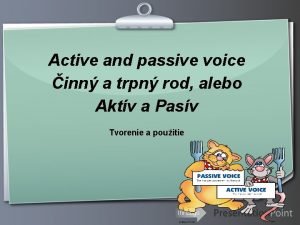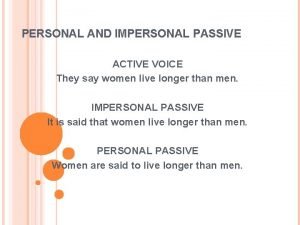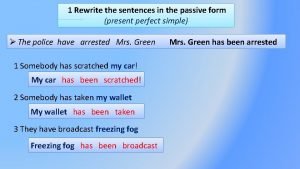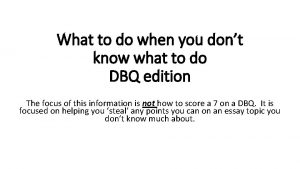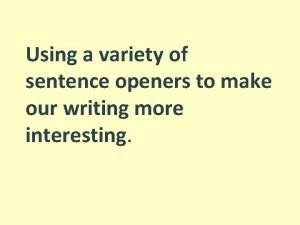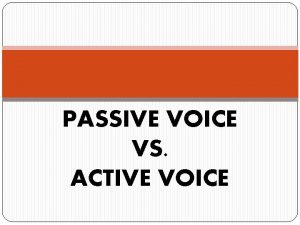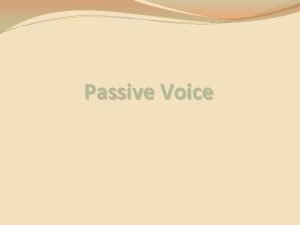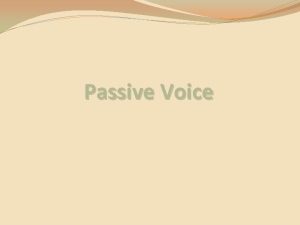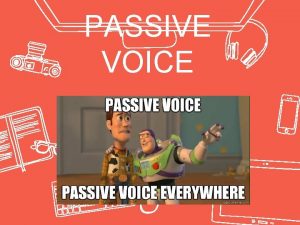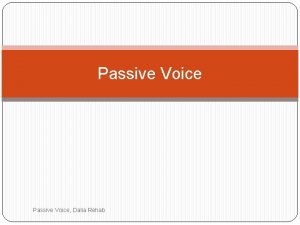The Passive Voice Year 7 Sentence Starters Icons




















- Slides: 20

The Passive Voice Year 7 Sentence Starters Icons key: For more detailed instructions, see the Getting Started presentation Flash activity. These activities are not editable. Extension activities 1 of 20 Web addresses Teacher’s notes included in the Notes Page Accompanying worksheet © Boardworks Ltd 2006

Contents Recognizing the passive voice Word order When to use the passive voice Writing in the passive voice Summary activities 2 of 20 © Boardworks Ltd 2006

The Passive Voice – Recognizing the passive voice 3 of 20 © Boardworks Ltd 2006

A writer’s voice Do you know the difference between the active and the passive voice Lei? No, I’m not sure. But I bet you don’t know either Max! Well you’re clearly not a passive person Lei! Why don’t we actively learn them together instead of arguing… 4 of 20 © Boardworks Ltd 2006

The passive voice Here are some sentences in the passive voice: The sulphuric acid was poured into a beaker. The thief was seen by several witnesses. The cherry was placed on top of the cake. The Reverend Green was killed in the library, a gun by Miss Plum. with Discuss why they are different to active (normal) sentences. 5 of 20 © Boardworks Ltd 2006

Recognizing the passive voice Click to see the active voice versions – what is different? The sulphuric acid was poured into a beaker. I poured the sulphuric acid into a beaker. The thief was seen by several witnesses. Several witnesses saw the thief. The Reverend Green was killed in the library with a gun by Miss Plum killed the Reverend Green in the library with a gun. 6 of 20 © Boardworks Ltd 2006

The Passive Voice – Word order 7 of 20 © Boardworks Ltd 2006

The object The trick to the active and passive voices is where the object lies in the sentence… In the active voice we write: 1. Subject 2. Verb 3. Object. For example: Romeo proposed to Juliet. In the passive voice the object is moved to the beginning: 1. Object 2. Verb 3. Subject. For example: Juliet was proposed to by Romeo. Or, the subject can be left out entirely in the passive voice: For example: Juliet was proposed to. What effect is created when the object is moved? 8 of 20 © Boardworks Ltd 2006

Identifying the different voices 9 of 20 © Boardworks Ltd 2006

The Passive Voice – When to use the passive voice 10 of 20 © Boardworks Ltd 2006

The purpose of the passive voice So we use the passive voice when… what happened is more important than who did it: The sulphuric acid was poured into a beaker. The action is vital, not who did it, so the subject is missing. the writer wants to create some suspense: The Reverend Green was killed in the library with a gun by Miss Plum. Readers want to know the name of the murderer, but using the passive voice makes them wait longer… Can you think of any other examples of when it is useful to write in the passive voice? 11 of 20 © Boardworks Ltd 2006

Knowing when to use each voice 12 of 20 © Boardworks Ltd 2006

The Passive Voice – Writing in the passive voice 13 of 20 © Boardworks Ltd 2006

Writing in the passive voice Rewrite these sentences in the passive voice: I broke the window. The window was broken. A man discovered stolen jewels whilst out walking his dog. The stolen jewels were discovered by a man out walking his dog. Ivor Brush painted the winning picture. The winning picture was painted by Ivor Brush. The police recovered the stolen car. The stolen car was recovered by the police. Were your answers similar to these? 14 of 20 © Boardworks Ltd 2006

Completing sentences activity Use these prompts to write some sentences in the passive voice: ……. . man…………………hunted……………police. Dave’s car…………stolen…………joy riders. The World Cup………won………………Italy. The entire pizza…………. eaten…………that night. 15 of 20 © Boardworks Ltd 2006

Answers Are these answers similar to yours? A man was being hunted by the police. Dave’s car was stolen by some joyriders. The World Cup was won by Italy. The entire pizza was eaten that night. 16 of 20 © Boardworks Ltd 2006

The Passive Voice – Summary activities 17 of 20 © Boardworks Ltd 2006

Test your knowledge 18 of 20 © Boardworks Ltd 2006

Changing the voice activity To write up a science experiment, it is best to use the passive voice, but Lei has written hers in the active voice. Can you rewrite her report using the passive voice? Purifying rock salts I ground the rock salt. I mixed it with water. Then I stirred it. I took a filter, folded it and put it in the funnel. Next I filtered the solution. Then I heated it. Finally, I left it to evaporate. 19 of 20 © Boardworks Ltd 2006

Summary So to sum it up, the passive voice… places the object at the start of the sentence often misses out the subject can be used when what has happened is more important than the subject used for creating suspense or mystery is often used when writing up factual reports e. g. science, news, police, legal, etc. 20 of 20 © Boardworks Ltd 2006
 Active and passive voice sentence structure
Active and passive voice sentence structure Voice structure chart
Voice structure chart Passive voice machine
Passive voice machine Present continuous passive
Present continuous passive Passive voice grammar
Passive voice grammar Passive voice cvičenia
Passive voice cvičenia Personal passive sentences
Personal passive sentences Rewrite the following sentence in the passive voice
Rewrite the following sentence in the passive voice Active and passive gerunds
Active and passive gerunds Retype the sentences in the passive.
Retype the sentences in the passive. Active sentences to passive
Active sentences to passive Counterclaim paragraph example
Counterclaim paragraph example Hipp apush
Hipp apush Interesting sentence openers
Interesting sentence openers Simile sentence openers
Simile sentence openers Socratic seminar sentence frames
Socratic seminar sentence frames Sentence starters for evidence
Sentence starters for evidence How to write an argumentative essay step by step
How to write an argumentative essay step by step Saq questions examples
Saq questions examples Planning for choices and changes
Planning for choices and changes Cer sentence starters
Cer sentence starters





